Pros
Cons
Introduction
Update: The JVC Everio GZ-MG670 was selected as our 2009 Standard Definition Camcorder of the Year. To see why we selected it and read about our other awards, check out the 2009 CamcorderInfo.com Select Awards.
Design
Front
{{section_header}}{{section.name}}{{/section_header}}

Back
{{section_header}}{{section.name}}{{/section_header}}

Left
{{section_header}}{{section.name}}{{/section_header}}
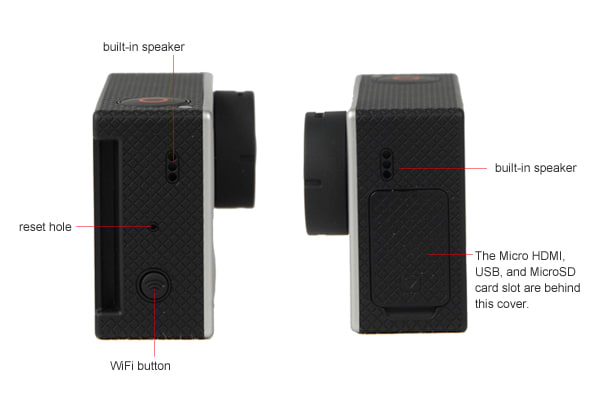
Right
{{section_header}}{{section.name}}{{/section_header}}
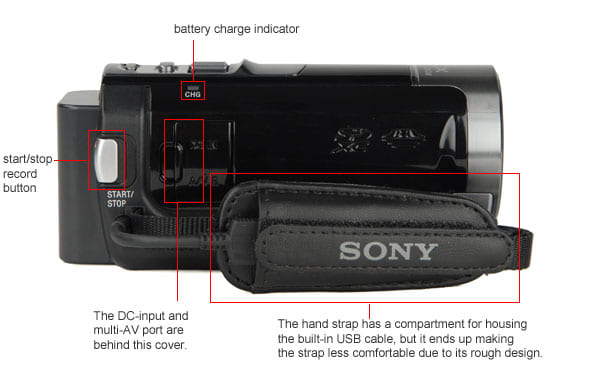
Top
{{section_header}}{{section.name}}{{/section_header}}

Bottom
{{section_header}}{{section.name}}{{/section_header}}

Size & Weight Comparison
{{section_header}}{{section.name}}{{/section_header}}
In the Box
{{section_header}}{{section.name}}{{/section_header}}

Performance
Color
{{section_header}}{{section.name}}{{/section_header}}
The DCR-SX60 showed us something in our color test that we commonly see with Sony camcorders—a decent color error score, but one that is slightly lower than other manufacturers. The SX60's color error came in at 4.11, which is not a bad score, but it is worse than the other three camcorders we compared it to in this review. The Sony also had a lower saturation level, 77.26%, than the competition. More on how we test color.
As you can see in the color test chart above and the color sample image below, the Sony DCR-SX60 didn't render colors poorly by any means. Its image looks good and the colors are fairly strong for a standard definition camcorder. In the error map above you can see the Sony did the best with certain red, brown and blue colors, while purples and greens gave it the most trouble.
The Sony DCR-SX60 does not have any color modes or image effect controls. The above image is a still frame from our color sample testing in which we used a manual white balance and automatic exposure settings. Below, you can see the Sony DCR-SX60 produces colors that appear quite similar to the Canon FS200 and Panasonic SDR-S26. The Samsung SMX-F34, on the other hand, shows some significantly different tones, particularly on the left portion of the test chart.
Even though the Sony SX60 may have slightly worse color accuracy than the other camcorders shown here, its color reproduction still looks quite good. Of course, the quality of produced colors is mainly a matter of personal preference. Some people may like the Colors captured by the Canon FS200, while others may find the Samsung SMX-F34 to be the best. All we can say for sure is that the Sony DCR-SX60 managed slightly less accurate colors according to our testing.
{{comparison_bars title="Color Score Comparison", attribute="Color Score", xLabel="Color Score"}}
Low Light Color
{{section_header}}{{section.name}}{{/section_header}}
The DCR-SX60 showed a huge drop in color accuracy when we ran the camcorder through our low light testing. Not only did the SX60 earn a mediocre color error of 7.11, but it also managed a very low saturation level of 42.82%. It is normal to see a drop in color accuracy in our low light testing, but the other camcorders in this set did not see their numbers fall as drastically. More on how we test low light color.
You can see in the comparisons below that the Canon and Sony camcorders have similarly dark images, but the Sony's colors are very bland compared to the Canon. The Panasonic SDR-S26 also has a very washed-out image in low light and it was the worst performer in our low light sensitivity test. At least the Sony maintained much of its sharpness in low light conditions, while the Panasonic did not. The Samsung SMX-F34 had a decent low light performance overall and its image below looks quite good.
Noise
{{section_header}}{{section.name}}{{/section_header}}
The DCR-SX60 averaged 1.0575% noise in our bright light test, which is kind of high. In fact, the Sony measured the highest noise levels among the standard definition camcorders we tested. Now, this isn't an outrageously high noise level, but it is still higher than average for a camcorder of its class. The good news is the Sony SX60's noise levels didn't get much worse when we tested the camcorder in low light. More on how we test noise.
The 100% crop images above give you a better idea of how each camcorder's bright light image compares. You can really see the color differences with the Samsung SMX-F34 when you look this close, and you can also notice the brighter green tones on the Canon FS200. It is difficult to get an idea of how sharp an image the camcorder is capable of capturing with these crops, but these four camcorders didn't show much of a difference in that arena. They are all standard definition models, which means they all struggled to capture a very sharp image. You can read more about our video sharpness results in the next section of this review.
{{comparison_bars title="Noise Score Comparison", attribute="Noise Score", xLabel="Noise Score"}}
Low Light Sensitivity
{{section_header}}{{section.name}}{{/section_header}}
The Canon FS200 and Samsung SMX-F34 did better than the Sony DCR-SX60 in this test, but the Sony didn't do as poorly as the Panasonic SDR-S26. The Sony SX60 required 15 lux of light to register 50 IRE on our waveform monitor, which is a fairly average score for a consumer camcorder. More on how we test low light sensitivity.
To improve its low light performance, the Sony SX60 does have an auto slow shutter feature, but using it will make motion look choppy (due to the camcorder using a 1/30 of a second shutter speed). None of these standard def camcorders offer alternate frame rates for recording video—a feature found on many HD models. We often see improved low light results when shooting using a 24p or 30p frame rate.
{{comparison_bars title="Low Light Sensitivity Comparison", attribute="Low Light Sensitivity Score", xLabel="Low Light Sensitivity Score"}}
Low Light Noise
{{section_header}}{{section.name}}{{/section_header}}
The SX60 averaged 1.1675% noise in our low light testing, which isn't much worse than the camcorder managed in bright light. This is a good sign for the Sony DCR-SX60 as it means the camcorder doesn't have a severe noise problem in low light. The Canon FS200 showed a bit less noise in its low light image, while the Samsung SMX-F34 had more. The Panasonic SDR-S26 registered nearly the same noise percentage as the Sony. More on how we test low light noise.
In the crops above you can see the Sony SX60's low light image does appear faded compared to the Canon FS200 and Samsung SMX-F34. The Panasonic SDR-S26, however, is the worst of the set with its very fuzzy low light image. The Samsung appears to retain the most detail in low light, but it also registered the highest noise levels. Overall, the Canon FS200 was probably the best low light performer in this set as it put up decent numbers in each of our low light tests.
{{comparison_bars title="Low Light Noise Score Comparison", attribute="Low Light Noise Score", xLabel="Low Light Noise Score"}}
Low Light Color
{{section_header}}{{section.name}}{{/section_header}}
The DCR-SX60 showed a huge drop in color accuracy when we ran the camcorder through our low light testing. Not only did the SX60 earn a mediocre color error of 7.11, but it also managed a very low saturation level of 42.82%. It is normal to see a drop in color accuracy in our low light testing, but the other camcorders in this set did not see their numbers fall as drastically. More on how we test low light color.
You can see in the comparisons below that the Canon and Sony camcorders have similarly dark images, but the Sony's colors are very bland compared to the Canon. The Panasonic SDR-S26 also has a very washed-out image in low light and it was the worst performer in our low light sensitivity test. At least the Sony maintained much of its sharpness in low light conditions, while the Panasonic did not. The Samsung SMX-F34 had a decent low light performance overall and its image below looks quite good.
Motion
{{section_header}}{{section.name}}{{/section_header}}
The Sony DCR-SX60 produced some bad results in our motion testing, although its motion video didn't look as bad as the Samsung SMX-F34. The camcorder rendered motion with more artifacting, pixelation, and jagged lines than the Canon FS200 and Panasonic SDR-S26, but it still managed to produce smooth video with not much trailing.
We're not sure why the Sony DCR-SX60 didn't perform as well as the Canon or Panasonic in this test. The Sony SX60 has the same size image sensor as the Panasonic SR26 (1/8-inch), and it records at a maximum bitrate of 9Mbps (the same as the Canon FS200). Still, despite the similar internal hardware, the Sony's footage simply didn't look as good in our motion test. The two pinwheels particularly showed a lot of pixelation and artifacting during our test.
For a standard definition camcorder, we liked the way the Canon FS200 rendered motion. Its image was smooth, motion trailing was kept to a minimum, and it didn't have as much artifacting as the models from Samsung and Sony. Still, just because the FS200's motion video was better than he competition doesn't mean it was perfect. There was still plenty of artifacting present in its image—as we've come to expect from an inexpensive standard definition camcorder.
The Samsung SMX-F34's image actually looked worse than the Sony DCR-SX60's in our motion test. The camcorder's motion video showed tons of artifacting and produced an extensive amount of blocky pixelation on the two rotating pinwheels. The SMX-F34 didn't have much trouble producing smooth motion, but the presence of artifacting and pixelation distracts from the smoothness. Part of the reason for the Samsung's poor performance here may be due to the fact that it records at a maximum bitrate of just 5Mbps, which is close to half the bitrate used by the Canon FS200, Sony DCR-SX60, and Panasonic SDR-S26.
The Panasonic SDR-S26 has a lot of deficiencies in low light, but in bright light its motion video looked rather good. We felt it was comparable to the Canon FS200 in quality, as it had less noticeable artifacting than the Samsung SMX-F34 and Sony DCR-SX60. More on how we test motion.
Video Sharpness
{{section_header}}{{section.name}}{{/section_header}}
Since we're dealing with a standard definition camcorder that shoots 720 x 480 video in this review, we didn't expect to see very good things coming from our video sharpness test. The Sony DCR-SX60 managed a horizontal sharpness of 350 lw/ph and a vertical sharpness of 200 lw/ph. While these are both very low scores compared to a camcorder that can shoot high definition video, these numbers are just about average for a standard definition camcorder. The Sony's sharpness score is actually slightly better than the Canon FS200 and Panasonic SDR-S26.
The thing to remember here is that if you are at all concerned about video sharpness you should be springing for an HD camcorder. Any HD model that shoots 1080p video will allow you to capture a far sharper and more detailed image than even the best SD camcorder. Some of the HD models we reviewed this year measured a horizontal sharpness around 800 lw/ph. Two models from JVC (the GZ-X900 and GZ-HM400) measured 1000 lw/ph. More on how we test video sharpness.
{{comparison_bars title="Video Sharpness Score Comparison", attribute="Video Sharpness Score", xLabel="Video Sharpness Score"}}
Testing Samples
{{section_header}}{{section.name}}{{/section_header}}
Usability
Ease of Use
{{section_header}}{{section.name}}{{/section_header}}
The Sony Handycam DCR-SX60 offers a smooth operating experience for even the newest videographers. The button layout is straightforward and the touchscreen interface is easy to understand. By pressing the Easy button inside the LCD cavity, the user can get an even more streamlined experience: there are very few options to get in your way. If you do opt to use the full range of features, you'll find the navigation fairly easy. Sony offers tool tips within the Option menu to explain each selection and a help button inside the Home menu will clear up some of the more confusing features.
Unfortunately, the rawest recruits might struggle with manual image controls and other advanced features, since Sony's explanations are minimalistic—both in the camcorder and in the user manual.
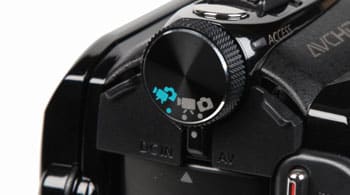
Auto Mode is confusingly called Dual Shot mode
The menu system of the DCR-SX60 is similar to most 2009 Sony camcorders. In the upper-left corner of the touchscreen is a button for activating the Home menu, while in the lower-right corner of the screen is a button for accessing the Option menu. While we do find this system easier to navigate than the new Sony menus (which feature one enormous scrolling menu), there's considerable ambiguity in dividing options into two different menus. Only one option is found in both the Home menu and the Option menu; for the others, you'll just have to guess which menu to search first.
Within the Home menu, there are a handful of submenus, the most important of which are the Movie Settings and Photo Settings submenus (see images below). This is where you get your more specific options—the ones that aren't in the Option menu, anyway. We like that you can change photo settings without entering photo mode. If it weren't for the separate Option menu, we would find these submenus very satisfactory for locating everything we need.
If the feature you want isn't in the Home menu (or one of the submenus within the Home menu), you might try looking in the Option menu. There's only one Home menu—the same no matter what mode you're in—but there's a different Option menu for record mode and the two playback modes.
Despite the confusing existence of two separate menus, Sony does make things easier by including tool tips, which appear at the bottom of the screen when you choose any item in the Option menu or a submenu within Home. The primary Home menu has its own system, which is a help feature you can activate and de-activate. Help mode will pop up a description when you tap on one of the options.
Like many camcorders, the SX60 has a beep that accompanies menu navigation. Not only can you disable this sound—a common feature on most camcorders—but you can also adjust its volume to one of 16 audio levels. That's a handy feature if you're annoyed by the sound but find a soft tone helpful in knowing when the touch screen recognizes your tap. Language options for the North American model are English, Spanish, French, and Portuguese.
Auto Mode
{{section_header}}{{section.name}}{{/section_header}}
The DCR-SX60 has a clearly labeled Easy Mode button inside the LCD cavity. In easy mode, the text and buttons on the LCD increase in size and decrease in complexity. Most noticeably, the Option menu is gone—users in this mode are not able to perform any manual image adjustments. The Home menu is also condensed, with only a handful of selections in each tab.
To make things even easier, the SX60 has the same tool tip features as the rest of the Sony lineup. Whether you're in Easy Mode or not, there is a Help function, which allows you to tap on items for slightly more involved descriptions. In certain submenus (and in the Option menu, if you're not in Easy mode), many options appear with an explanatory description at the bottom of the LCD. Unfortunately, none of these tool tips and descriptions are particularly thorough. However, we greatly appreciate the effort that Sony makes to give consumers something navigable.
As for how the camcorder handles automatic image adjustment, there are some features that work better than others. You'll experience a bit of a delay just about any time you make a sudden shift in recording subject. Exposure is particularly noticeable: going from a dark to bright background definitely takes a moment. Focus and white balance shifts are usually more subtle.
Low Light Modes - The DCR-SX60 does not have any true low light modes. There is an auto slow shutter option (called Low Lux on higher-end Sony models), but this simply allows the camcorder to record in a slower shutter speed. You'll find a similar option on dozens of camcorders and, honestly, we don't think it's a very good way to boost low light performance. When the shutter speed decreases, it only results in painfully blurry motion trailing. A true low light mode combines aperture, shutter speed, and gain to brighten your footage. We do, however, appreciate that Sony gives us the choice to turn auto slow shutter off, since there are plenty of consumers that prefer dimmer video to blurry video.
Scene Modes - There are number of scene modes on the DCR-SX60: Twilight, Candle, Sunrise & Sunset, Fireworks, Landscape, Portrait, Spotlight, Sports, Beach, and Snow. Some of these scene modes change the shutter speed, while others alter the white balance and color tones. All scene modes are available in photo mode as well.
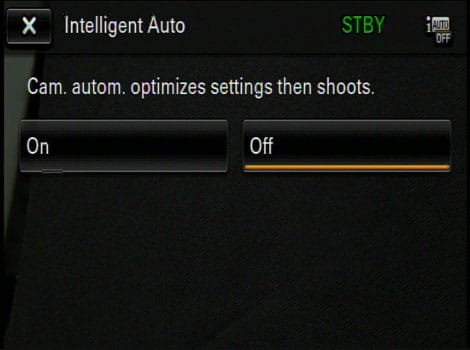
The iAuto mode button is difficult to find, but when you do find it the option for turning on the mode looks like this.
Other Auto Features
Portability
{{section_header}}{{section.name}}{{/section_header}}
Like most standard definition camcorders these days, the DCR-SX60 is small and light. With 16GB of internal memory, you won't have to worry about carrying around lots of extra media. (You just need to make sure that you transfer your files from time to time.) Although the SX60 definitely feels cheaper than Sony's high definition line, it still feels rugged enough to withstand moderate wear and tear. Putting it in a properly lined camera bag and making sure you close the manual lens cover will definitely lengthen the SX60's lifespan.
Battery Life
{{section_header}}{{section.name}}{{/section_header}}
The DCR-SX60 did not show exceptional battery life, when compared to other standard definition camcorders in this price range. In our battery test, the Handycam lasted just 2h 10m 5s (about 130 minutes). The Canon FS200 and Samsung SMX-F34 lasted much longer. Of course, the SX60 does have an open-back battery compartment, so you can certainly purchase a larger battery if you'd like to record longer shoots. More on how we test battery life.

{{comparison_bars title="Battery Life Comparison", attribute="Battery Life Score", xLabel="minutes"}}
LCD
{{section_header}}{{section.name}}{{/section_header}}
The SX60 Handycam has a standard 2.7-inch LCD with a resolution of 123,200 pixels. That's definitely the low-end of camcorder displays, especially compared to the 3-inch and 3.2-inch LCDs on top-of-the-line Sony camcorders. Like most Sony camcorders, the SX60 LCD is a touchscreen, which can be calibrated from within the menus.
Though the side and resolution of the LCD is modest, the SX60 does offer a surprising level of control over the display. There is a backlight feature, which can be set to either 'normal' or 'bright,' as well as a manual LCD brightness adjustment with 32 increments available. Even more surprising is the LCD color tool, which lets you adjust color 'intensity' to one of 16 levels. Most expensive high definition camcorders don't have all of these options... it's nice that Sony decided to extend the feature to its entire consumer lineup. Of course, keep in mind that making adjustments to the LCD does not impact your final footage and may give you a false impression of what that footage will look like.
The SX60 does not have a viewfinder, so you'll be relying on this LCD quite a lot. Viewfinders are all but extinct on standard definition camcorders, since it's now seen as more of a 'prosumer' tool.
Stabilization
{{section_header}}{{section.name}}{{/section_header}}
Sony calls its stabilization Steadyshot—whether the camcorder uses optical or digital stabilization. In the case of the Sony DCR-SX60, Steadyshot refers to a digital image stabilization system. The Steadyshot did show some minor improvement over camera shake, but it was nothing to get too excited about. During our low shake test, the SX60's Steadyshot resulted in only a 10% shake correction. The low shake results were even less impressive: just 6% correction. More on how we test stabilization.
The graphs above show how well the camcorder's stabilization system works. The blue lines represent the SX60's motion with Steadyshot turned off, while the orange lines show the camcorder's motion with stabilization engaged. You can see that the patterns are virtually identical, with the orange lines only slightly more condensed than the blue. In the video below you can see the Steadyshot in action.
We find, in general, that digital image stabilization is less effective than optical image stabilization. For instance, the SX60 stabilization was about as good as the Canon FS200 and even better than the Samsung SMX-F34. However, the optical image stabilization of the Panasonic SDR-S26 was far more effective than any of these camcorders, with over 40% correction on both low and high shake.
Manual Focus
{{section_header}}{{section.name}}{{/section_header}}
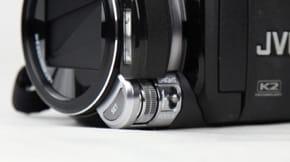
The adjustment dial makes accurate focus adjustments easy.
Manual Exposure
{{section_header}}{{section.name}}{{/section_header}}
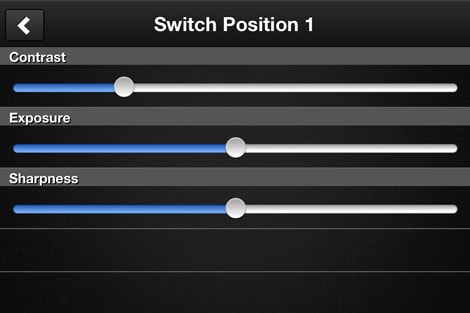
The manual exposure controls are only found on the Contour app, not on the camcorder itself.
Miscellaneous Controls
{{section_header}}{{section.name}}{{/section_header}}
Guideframe
Splits the screen into nine equal sectors to assist with framing. The lines don't end up on your recorded video.
Tele Macro
Allows you to focus clearly on close-up subjects when using a full optical zoom. The camcorder automatically sets the zoom to tele when Tele Macro is engaged and changing the zoom will turn off the Tele macro setting.
Audio Controls
{{section_header}}{{section.name}}{{/section_header}}
Editing
{{section_header}}{{section.name}}{{/section_header}}
The DCR-SX60 comes with the same software as previous Sony models. The recently released CX500V has an updated version of Picture Motion Browser (version 4.2.14), but it doesn't appear that you're missing any noteworthy upgrades with the 4.2.00 version. The software is not compatible with Macs, but it will work on Windows XP or Windows Vista.
We like Sony's PMB software for its versatility, but it isn't the easiest program to use—particularly when dealing with its more advanced features. Thankfully, Picture Motion Browser does do the most thing pretty well: it can copy footage from the camcorder to your computer fairly seamlessly. There are also some simple DVD creation options that are fairly easy to use, and the clip organization and YouTube upload options work well.
Despite the fairly simple importing process, the editing interface is not intuitive. Each time you start a new task, a new window opens up, making the software seem more complicated than it really is. The layout for more complex function—like trimming—is just a little convoluted. If you plan to do extensive editing, we advise you to use a more fully featured editing program. For an overview of the software that ships with this and other camcorders, see our article: Video Editing Software For Your Camcorder{{product.brand.name}}-Included-Software.htm.
Features
Compression
{{section_header}}{{section.name}}{{/section_header}}
The Sony DCR-SX60 records standard definition video in the typical MPEG-2 video format. Unlike the competition, Sony actually outputs these files with the .mpg extension (instead of the annoying .mod you see on Canon and Panasonic standard def camcorders). However, there's a catch: the .mpg files created by the SX60 seem capable of being dragged, dropped, and played on any old media player, but that's not always the case. Many media players will require a plug-in to play these files and most will not play the files with audio attached. This comes in handy if you just want to watch a quick preview on your computer, but it can be confusing too. If you want the whole video (with audio included), you'll need to use editing software to import your footage.
Video recorded by the Sony DCR-SX60 is captured at a 720 x 480 resolution. The camcorder has three recording quality options—HQ, SP, and LP—each of which uses a different bitrate (HQ is the highest quality setting). You can also change the frame size to record a 4:3 aspect ratio. Read more about the advantages and disadvantages of various high definition compression types.
Media
{{section_header}}{{section.name}}{{/section_header}}
The Sony DCR-SX60 records primarily to 16GB of internal flash memory. This is the largest capacity available for Sony's standard definition flash camcorders. The SX60's sister models, the DCR-SX40 and SX41 have 4GB and 8GB, respectively. Sony also manufactures similar products in its hard drive line: the DCR-SR47 and DCR-SR67 have 60GB and 80GB hard drives. Though hard drive models like these currently have the potential for higher capacity, they are more expensive and slightly less reliable than internal flash memory camcorders. They also have a less compact form factor, since the hard disc drive requires more space inside the camcorder than internal flash memory.
For added flexibility, the SX60 can also record to removable Memory Stick Pro Duo cards. Unfortunately, this type of memory card is a proprietary Sony format; Memory Sticks can only be used in Sony products. Read more about the advantages and disadvantages of various media types.

Slow Motion Modes
Still Features
{{section_header}}{{section.name}}{{/section_header}}
The SX60 is a mediocre choice indeed if you're looking for something to replace a dedicated still camera. Most standard definition camcorders so not take good still photos, since their sensors are comparatively low in resolution. Perhaps Sony knows that this won't be a primary use of the SX60, for it gives the user very few options in still photography.
There is, in fact, a dedicated still mode, but only 640-pixel wide photos can be taken (in one of two aspect ratios). The limited manual controls that are available in video mode are available here too, but that isn't saying much. There's no aperture or shutter control—and certainly no ISO options. There aren't any quality options and there is no flash. The only additional feature that still photography grants the user is a ten-second self-timer.
The Sony DCR-SX60 had average still performance for a standard definition camcorder. As we mentioned above, no standard def camcorder is really cut out for still photography—even a cheap point and shoot camera will do the job better. In a pinch, however, the SX60 will at least reproduce fairly accurate colors. Its 4.0 color accuracy was dead average, though the 86.56% saturation is low, even for a camcorder.
The 1.16% noise measured during our still photo testing isn't very good—even for a standard definition camcorder. Again, the SX60 simply isn't meant to replace the most basic dedicated still camera. Even the Canon FS200, which fared well on other photo tests, turned in a poor performance here. The models from Samsung and Panasonic were slightly better, but still mediocre.
Still sharpness is the one area in which all standard definition camcorders fail to live up to expectations. Even the most basic point-and-shoot camera can capture more detail than the photo modes of these camcorders. Still, if you're in a bind, the SX60 is not the worst option available.
Lens & Imaging System
{{section_header}}{{section.name}}{{/section_header}}

The Sony Handycam DCR-SX60 has a simple Carl Zeiss Vario-Tessar lens with a minimum focal range of 1.8mm and 60x optical zoom. There are no filter threads and the lens is protected by a manual lens cover, which can be opened or closed by a switch on the right side of the lens.
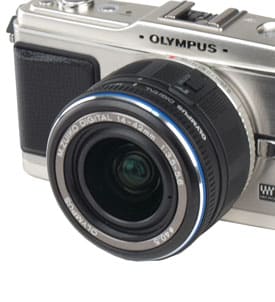
LCD
{{section_header}}{{section.name}}{{/section_header}}
The SX60 Handycam has a standard 2.7-inch LCD with a resolution of 123,200 pixels. That's definitely the low-end of camcorder displays, especially compared to the 3-inch and 3.2-inch LCDs on top-of-the-line Sony camcorders. Like most Sony camcorders, the SX60 LCD is a touchscreen, which can be calibrated from within the menus.
Though the side and resolution of the LCD is modest, the SX60 does offer a surprising level of control over the display. There is a backlight feature, which can be set to either 'normal' or 'bright,' as well as a manual LCD brightness adjustment with 32 increments available. Even more surprising is the LCD color tool, which lets you adjust color 'intensity' to one of 16 levels. Most expensive high definition camcorders don't have all of these options... it's nice that Sony decided to extend the feature to its entire consumer lineup. Of course, keep in mind that making adjustments to the LCD does not impact your final footage and may give you a false impression of what that footage will look like.
The SX60 does not have a viewfinder, so you'll be relying on this LCD quite a lot. Viewfinders are all but extinct on standard definition camcorders, since it's now seen as more of a 'prosumer' tool.
Connectivity
{{section_header}}{{section.name}}{{/section_header}}
As a standard definition camcorder, the SX60 doesn't include much in the way of connectivity. In fact, you'll find just the bare minimum when it comes to ports and jacks. There is no accessory shoe, no mic/headphone ports, and no HDMI interface.
Inside the LCD cavity is a single USB port. It is not covered by a door or rubber covering, which is unusual. The LCD panel itself will protect the USB output, but only when it's closed. With the LCD panel open, the port is exposed to the elements.
Fortunately, the DC power input and AV output are more well protected: a hinged door on the right side of the camcorder protects these vital ports. It is a bit inconvenient to have the ports tucked away beneath the hand strap, but your default hand strap setting will probably leave plenty of room to open the door and access the ports. Note that the AV output is a proprietary connection; only Sony cables will work with the port. Fortunately, the SX60 does ship with a composite AV cable to fit this jack.
One final connectivity option will be of interest to many users: the Memory Stick PRO Duo card slot. This can be used to record either videos or photos and is an easy way to transfer files to your computer, Sony television, or PS3. That's in addition to the 16GB of internal flash memory.
Media
{{section_header}}{{section.name}}{{/section_header}}
The Sony DCR-SX60 records primarily to 16GB of internal flash memory. This is the largest capacity available for Sony's standard definition flash camcorders. The SX60's sister models, the DCR-SX40 and SX41 have 4GB and 8GB, respectively. Sony also manufactures similar products in its hard drive line: the DCR-SR47 and DCR-SR67 have 60GB and 80GB hard drives. Though hard drive models like these currently have the potential for higher capacity, they are more expensive and slightly less reliable than internal flash memory camcorders. They also have a less compact form factor, since the hard disc drive requires more space inside the camcorder than internal flash memory.
For added flexibility, the SX60 can also record to removable Memory Stick Pro Duo cards. Unfortunately, this type of memory card is a proprietary Sony format; Memory Sticks can only be used in Sony products. Read more about the advantages and disadvantages of various media types.

Still Features
{{section_header}}{{section.name}}{{/section_header}}
The SX60 is a mediocre choice indeed if you're looking for something to replace a dedicated still camera. Most standard definition camcorders so not take good still photos, since their sensors are comparatively low in resolution. Perhaps Sony knows that this won't be a primary use of the SX60, for it gives the user very few options in still photography.
There is, in fact, a dedicated still mode, but only 640-pixel wide photos can be taken (in one of two aspect ratios). The limited manual controls that are available in video mode are available here too, but that isn't saying much. There's no aperture or shutter control—and certainly no ISO options. There aren't any quality options and there is no flash. The only additional feature that still photography grants the user is a ten-second self-timer.
The Sony DCR-SX60 had average still performance for a standard definition camcorder. As we mentioned above, no standard def camcorder is really cut out for still photography—even a cheap point and shoot camera will do the job better. In a pinch, however, the SX60 will at least reproduce fairly accurate colors. Its 4.0 color accuracy was dead average, though the 86.56% saturation is low, even for a camcorder.
The 1.16% noise measured during our still photo testing isn't very good—even for a standard definition camcorder. Again, the SX60 simply isn't meant to replace the most basic dedicated still camera. Even the Canon FS200, which fared well on other photo tests, turned in a poor performance here. The models from Samsung and Panasonic were slightly better, but still mediocre.
Still sharpness is the one area in which all standard definition camcorders fail to live up to expectations. Even the most basic point-and-shoot camera can capture more detail than the photo modes of these camcorders. Still, if you're in a bind, the SX60 is not the worst option available.
Samsung SMX-F34 Comparison
The story of the Canon FS200 is all about performance. Quite frankly, the FS200 knocks the SX60 out of the ballpark in just about every test. The only areas in which the two performed similarly were video sharpness and stabilization. That doesn't leave many compelling reasons to purchase the SX60 over the FS200. Both are easy to use, but the Canon has the advantage in features (including manual controls), performance, and—in our opinion—aesthetics. The SX60 does have 16GB of internal flash memory, but so does the FS200's sister model, the FS21.
If you strongly prefer touchscreen navigation, you may opt for the Sony, but do so against our recommendation.
Update: The Canon FS200 was selected as our 2009 runner-up for Standard Definition Camcorder of the Year (behind the JVC GZ-MG670). To see why we selected it and read about our other awards, check out the 2009 CamcorderInfo.com Select Awards.
Panasonic SDR-S26 Comparison
The Samsung doesn't quite outclass the SX60 as the FS200 does (see previous page for a comparison), but it does outperform the Sony in a number of important areas. Color and noise performance in bright light are superior and low light performance in general is far better. Admittedly, the motion of the F34 shows more evidence of compression artifacting and the Samsung's digital image stabilization is practically useless, but the performance in general is impressive enough to warrant serious consideration by those shopping for standard definition camcorders.
What we really like about the F34 is its usability: it's even easier to navigate than the SX60 and has a great swivel hand grip that makes it comfortable to hold from a variety of shooting positions. This is all $60-$100 cheaper than the Sony Handycam. For us, that makes the Samsung SMX-F34 a clear winner.
COMP 3
While the Panasonic SDR-S26 does have a slight edge over the the SX60 in terms of performance, the advantages aren't as clear cut as they might be with some of the competition. The S26 beats the SX60 when it comes to color and noise in bright light, but the SX60 boasts better scores in sharpness and, more importantly, low light sensitivity. The S26 simply is not a winner when you turn the lights down, and that includes a lot of indoor shooting conditions where camcorders are often used. The one major advantage that the S26 has is an optical stabilization system, which fared much better than the digital systems of the Handycam and most other standard definition cams. If stabilization is important to you, the Panasonic S26 is a clear choice.
However, in all other aspects, we're not sure there's a winner between these two. Both are relatively easy to use and both have a substantial optical zoom ratio (60x on the Sony and 70x on the Panasonic). The Panasonic has more manual controls, but the Sony is more compact and has a good touchscreen interface. It's a close call, but we would probably pick the Sony DCR-SX60 to win in this battle. Or neither. Competing models from Canon, JVC, and Samsung all give you more for your money.
Conclusion
There are few compelling reasons to choose the Sony Handycam DCR-SX60 over any number of competing models. Standard definition camcorders from JVC and Canon will give you better video performance and are just as easy to use. The only real advantage of the SX60 is its touchscreen interface, which some users may enjoy.
In our book, however, this isn't reason enough to purchase the SX60 when so many superior performers are out there for the the same price.
Photo Gallery
{{photo_gallery "Front Photo", "Left Photo", "Left Open Photo", "Back Photo", "Right Photo", "Top Photo", "Bottom Photo", "Lens Photo", "Lens Photo 2", "3D Lens Photo", "Media Photo", "Easy Mode Photo", "Manual Controls Photo", "Zoom Photo", "Zoom Photo 2", "Ease of Use Photo", "Battery Photo", "LCD Photo 1", "LCD Photo 2", "EVF Photo 1", "EVF Photo 2", "Mic Photo", "Mic Photo 2", "Ports Photo 1", "Ports Photo 2", "Ports Photo 3", "Ports Photo 4", "Ports Photo 5", "Ports Photo 6", "Handling Photo 1", "Handling Photo 2", "Handling Photo 3", "Handling Photo 4", "Box Photo"}}
Meet the tester
Vice President of Editorial Management, Kaitlyn oversees the editorial departments of Reviewed.com’s various sites. She has been writing about technology since the turn of the century. Outside of her Reviewed.com home, Kaitlyn is also a theatre director and avid gamer.
Checking our work.
Our team is here to help you buy the best stuff and love what you own. Our writers, editors, and experts obsess over the products we cover to make sure you're confident and satisfied. Have a different opinion about something we recommend? Email us and we'll compare notes.
Shoot us an email